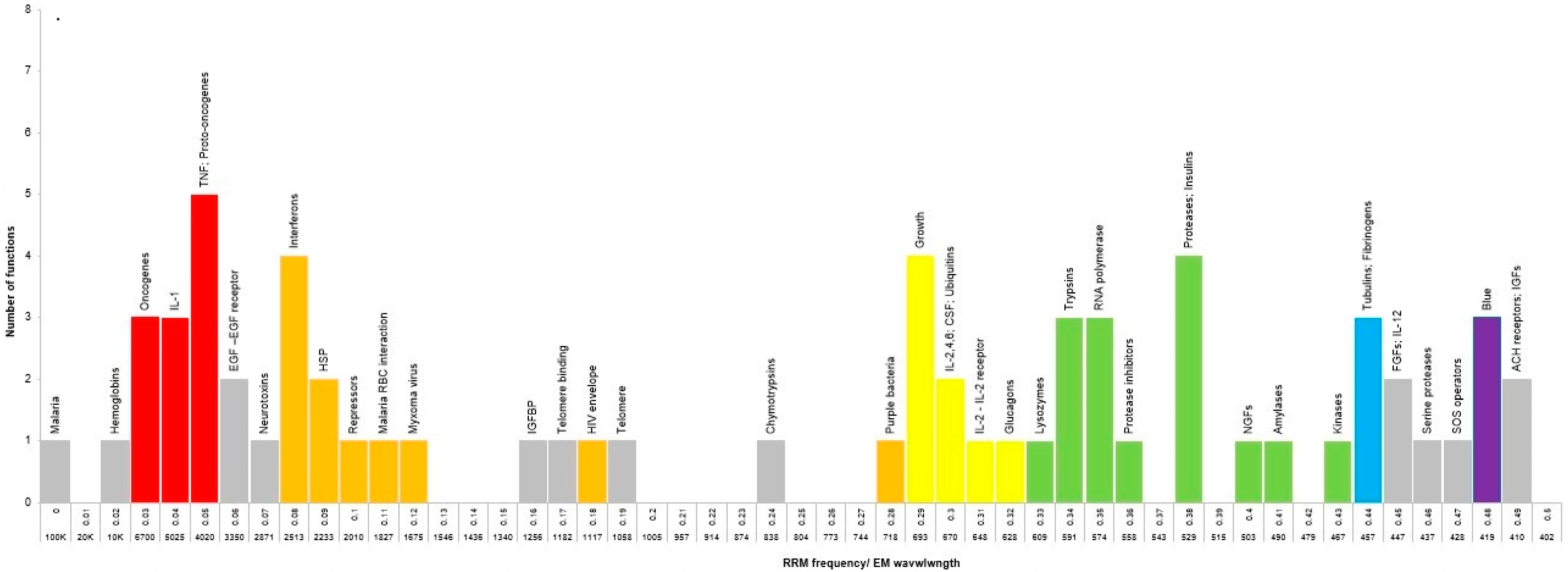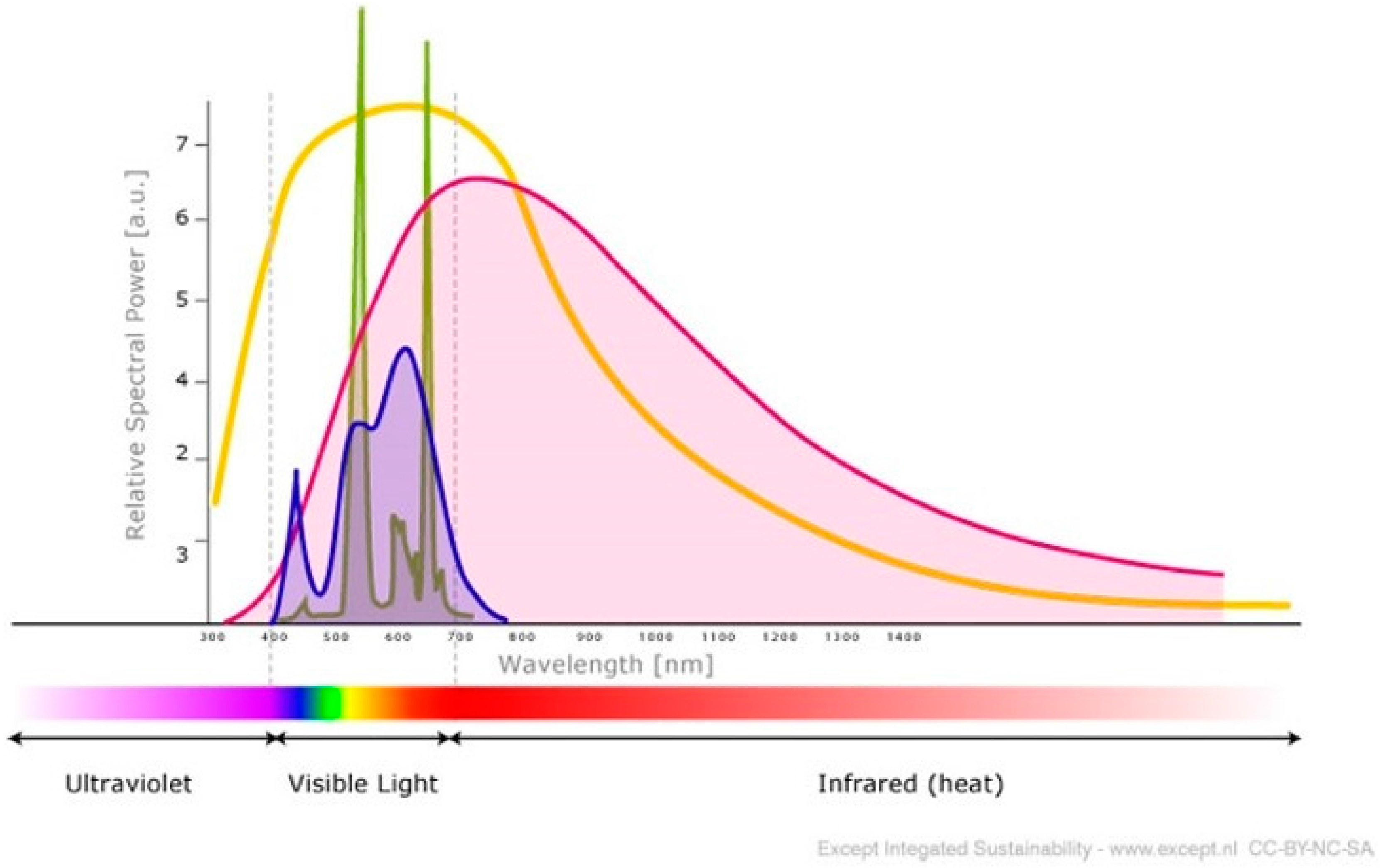Environmental Light and Its Relationship with Electromagnetic Resonances of Biomolecular Interactions, as Predicted by the Resonant Recognition Model
Abstract
:1. Introduction
- whole RRM spectrum for different biological functions of proteins and DNA;
- grouping of different biological functions into super families;
- comparison of RRM spectrum with the water absorption spectrum, spectrum of sunlight and spectrum of some artificial sources of light.
2. Materials and Methods
Resonant Recognition Model
- Laser light growth promotion of cells, by using the particular frequencies of light to produce the similar effect to that of growth factor proteins;
- chymotrypsin activation (increase of enzyme activity) achieved by laser light radiation in a range of 850–860 nm;
- activation of highly homologous plant photoreceptors which, although being very homologous, absorb different wavelengths of light;
- photo activated proteins, e.g., rhodopsin, flavodoxin, etc.
3. Results
4. Discussion
4.1. Functional Super Families
4.2. Water Absorption
4.3. Artificial Light
5. Conclusions
Acknowledgments
Author Contributions
Conflicts of Interest
References
- Cifra, M.; Brouder, C.; Nerudova, M.; Kucera, O. Biophotons, coherence and photocount statistics: A critical review. J. Lumin. 2015. [Google Scholar] [CrossRef]
- Cifra, M.; Pospisil, P. Ultra-weak photon emission from biological samples: Definition, mechanisms, properties, detection and applications. J. Photochem. Photobiol. B Biol. 2014, 139, 2–10. [Google Scholar] [CrossRef] [PubMed]
- Cosic, I. Macromolecular bioactivity: Is it resonant interaction between macromolecules? IEEE Trans. Biomed. Eng. Theory Appl. 1994, 41, 1101–1114. [Google Scholar] [CrossRef] [PubMed]
- Cosic, I. The Resonant Recognition Model of Macromolecular Bioactivity: Theory and Applications; Birkhauser Verlag: Basel, Switzerland, 1997. [Google Scholar]
- Cosic, I.; Lazar, K.; Cosic, D. Prediction of Tubulin resonant frequencies using the Resonant Recognition Model (RRM). IEEE Trans. NanoBiosci. 2015, 12, 491–496. [Google Scholar] [CrossRef] [PubMed]
- Cosic, I.; Cosic, D.; Lazar, K. Is it possible to predict electromagnetic resonances in proteins, DNA and RNA? Nonlinear Biomed. Phys. 2015. [Google Scholar] [CrossRef]
- Cosic, I. Resonant Recognition Model of Protein-Protein and Protein-DNA Recognition, in Bioinstrumentation and Biosensors; Marcel Dekker Inc.: New York, NY, USA, 1990; pp. 475–510. [Google Scholar]
- Vojisavljevic, V.; Pirogova, E.; Cosic, I. The effect of electromagnetic radiation (550 nm–850 nm) on i-Lactate Dehydrogenase Kinetics. Int. J. Radiat. Biol. 2007, 83, 221–230. [Google Scholar] [CrossRef] [PubMed]
- Dotta, B.T.; Murugan, N.J.; Karbowski, L.M.; Lafrenie, R.M.; Persinger, M.A. Shifting wavelength of ultraweak photon emissions from dying melanoma cells: Their chemical enhancement and blocking are predicted by Cosic’s theory of resonant recognition model for macromolecules. Naturwissenschaften 2014, 101. [Google Scholar] [CrossRef] [PubMed]
- Murugan, N.J.; Karbowski, L.M.; Persinger, M.A. Cosic’s Resonance recognition model for protein sequences and photon emission differentiates lethal and non-lethal ebola strains: Implications for treatment. Open J. Biophys. 2014, 5, 35–43. [Google Scholar] [CrossRef]
- Karbowski, L.M.; Murugan, N.J.; Persinger, M.A. Novel Cosic resonance (standing wave) solutions for components of the JAK-STAT cellular signalling pathway: A convergence of spectral density profiles. FEBS Open Biol. 2015, 5, 245–250. [Google Scholar] [CrossRef] [PubMed]
- Cosic, I.; Cosic, D.; Lazar, K. Analysis of tumor necrosis factor function using the resonant recognition model. Cell Biochem. Biophys. 2016, 74, 175–180. [Google Scholar] [CrossRef] [PubMed]
- Istivan, T.; Pirogova, E.; Gan, E.; Almansour, N.; Coloe, P.; Cosic, I. Biological effects of a De Novo designed myxoma virus peptide analogue: Evaluation of cytotoxicity on tumor cells. PLoS ONE 2011, 6, e24809. [Google Scholar] [CrossRef] [PubMed]
- Almansour, N.; Pirogova, E.; Coloe, P.; Cosic, I.; Istivan, T. Investigation of cytotoxicity of negative control peptides vs. bioactive peptides on skin cancer and normal cells: A comparative study. Future Med. Chem. 2012, 4, 1553–1565. [Google Scholar] [CrossRef] [PubMed]
- Peidaee, P.; Almansour, N.M.; Pirogova, E. In vitro evaluation of low-intensity light radiation on murine melanoma (B16F10) cells. Med. Biol. Eng. Comput. 2016, 54, 325–332. [Google Scholar] [CrossRef] [PubMed]
- Cosic, I.; Drummond, A.E.; Underwood, J.R.; Hearn, M.T.W. In vitro inhibition of the actions of basic FGF by a novel 16 amino acid peptides. Mol. Cell. Biochem. 1994, 130, 1–9. [Google Scholar] [CrossRef] [PubMed]
- Krsmanovic, V.; Biquard, J.M.; Sikorska-Walker, M.; Cosic, I.; Desgranges, C.; Trabaud, M.A.; Whitfield, J.F.; Durkin, J.P.; Achour, A.; Hearn, M.T.W.; et al. Investigation into the Cross-reactivity of Rabbit Antibodies Raised against nonhomologous Pairs of Synthetic Peptides Derived from HIV-1 gp120 proteins. J. Peptide Res. 1998, 52, 410–412. [Google Scholar] [CrossRef]
- Cosic, I.; Caceres, J.L.H.; Cosic, D. Possibility to interfere with malaria parasite activity using specific electromagnetic frequencies. EPJ Nonlinear Biomed. Phys. 2015. [Google Scholar] [CrossRef]
- Katz, B. How to Light Art Glass—Lighting Art Guide. 2015. Available online: https://bernardkatz.com (accessed on 28 June 2016).
- Karbowski, L.M.; Murugan, N.J.; Persinger, M.A. Experimental evidence that specific photon energies are “Stored” in malignant cells for an hour: The synergism of weak magnetic Field-LED wavelength pulses. Biol. Med. 2016, 8, 1–8. [Google Scholar]


| RRM Frequency | Nano Meters | Functional Group | Super Family |
|---|---|---|---|
| 0.002 | 100 K | Circumsporosoite, PfEMP1, EBA, ICHIT (malaria) | |
| 0.0234 | 20 K | Hemoglobin | |
| 0.027 | 7444 | Protein A-VHIII | Tumor regulation |
| 0.031 | 6484 | Antitumor agents (TNF + IL-2 + IFN-beta + human M-CSF) | |
| 0.0313 | 6422 | Oncogenes | |
| 0.039 | 5154 | IL-1 | |
| 0.0430 | 4674 | Phospholipases | |
| 0.0439 | 4579 | Insulin multimer | |
| 0.0446 | 4508 | Glucocorticoide receptors | |
| 0.0459 | 4379 | Homeo box proteins | |
| 0.0488 | 4119 | Enhancers | |
| 0.049 | 4102 | TNF receptors | |
| 0.051 | 3941 | TNFs | |
| 0.054 | 3722 | Proto-oncogenes | |
| 0.0590 | 3407 | Cytochrome B | |
| 0.062 | 3242 | EGF–EGF receptor | |
| 0.0703 | 2859 | Neurotoxins | |
| 0.0781 | 2574 | Operators | |
| 0.0820 | 2451 | Interferons | |
| 0.0820 | 2451 | Myoglobins | |
| 0.0839 | 2396 | Bacterial repressors | Viral–bacterial infection |
| 0.0947 | 2122 | Heat shock proteins | |
| 0.096 | 2094 | Tubulins A + B | |
| 0.0990 | 2030 | Repressors | |
| 0.1054 | 1907 | Phage repressors | |
| 0.110 | 1827 | EBA-RBC (malaria interaction with red blood cells) | |
| 0.115 | 1748 | Myxoma virus | |
| 0.162 | 1241 | IGFBP | |
| 0.173 | 1162 | Telomere binding | |
| 0.186 | 1081 | HIV envelope | |
| 0.188 | 1069 | Telomere | |
| 0.2363 | 851 | Chymotrypsins | |
| 0.281 | 715 | Purple (bacteria) | |
| 0.285 | 705 | TERT + telomerase RNA + progerin | Growth |
| 0.288 | 698 | EGFs | |
| 0.289 | 695 | Growth hormons + NGF + proliferins | |
| 0.2929 | 686 | Growth factors (CSF + EGF + IL-2) | |
| 0.297 | 678 | CSF, Ubiquitins, EPA | |
| 0.300 | 670 | IL-2, IL-4, IL-6 | |
| 0.308 | 653 | IL-2—IL2 receptor | |
| 0.3203 | 628 | Glucagons | |
| 0.3281 | 613 | Lysozymes | Enzymes |
| 0.3400 | 591 | Myosins | |
| 0.3437 | 585 | Promoters | |
| 0.3447 | 583 | Trypsins | |
| 0.346 | 581 | Red (rhodopsin) | |
| 0.35 | 574 | RNA polymerase | |
| 0.355 | 566 | Green (rhodopsin and chlorophylls) | |
| 0.3555 | 565 | Protease inhibitors | |
| 0.3770 | 533 | Proteases | |
| 0.379 | 530 | Flavodoxins | |
| 0.3828 | 525 | Insulin receptors | |
| 0.383 | 525 | Insulins | |
| 0.4040 | 498 | NGFs | |
| 0.4121 | 488 | Amylases | |
| 0.4297 | 468 | Kinases | |
| 0.434 | 463 | Tubulins beta | Structural proteins |
| 0.4423 | 454 | Fibrinogens | |
| 0.449 | 448 | Tubulins alpha | |
| 0.4512 | 445 | FGFs, FGF receptors | |
| 0.453 | 444 | IL-12 | |
| 0.4609 | 436 | Serine proteases | |
| 0.4687 | 429 | SOS operators | |
| 0.475 | 423 | Blue (rhodopsin and bioluminescent proteins) | Blue |
| 0.4765 | 422 | Cytochrome C | |
| 0.4800 | 419 | Actins | |
| 0.4922 | 408 | ACH receptors | |
| 0.4922 | 408 | IGFs |
© 2016 by the authors; licensee MDPI, Basel, Switzerland. This article is an open access article distributed under the terms and conditions of the Creative Commons Attribution (CC-BY) license (http://creativecommons.org/licenses/by/4.0/).
Share and Cite
Cosic, I.; Cosic, D.; Lazar, K. Environmental Light and Its Relationship with Electromagnetic Resonances of Biomolecular Interactions, as Predicted by the Resonant Recognition Model. Int. J. Environ. Res. Public Health 2016, 13, 647. https://doi.org/10.3390/ijerph13070647
Cosic I, Cosic D, Lazar K. Environmental Light and Its Relationship with Electromagnetic Resonances of Biomolecular Interactions, as Predicted by the Resonant Recognition Model. International Journal of Environmental Research and Public Health. 2016; 13(7):647. https://doi.org/10.3390/ijerph13070647
Chicago/Turabian StyleCosic, Irena, Drasko Cosic, and Katarina Lazar. 2016. "Environmental Light and Its Relationship with Electromagnetic Resonances of Biomolecular Interactions, as Predicted by the Resonant Recognition Model" International Journal of Environmental Research and Public Health 13, no. 7: 647. https://doi.org/10.3390/ijerph13070647
APA StyleCosic, I., Cosic, D., & Lazar, K. (2016). Environmental Light and Its Relationship with Electromagnetic Resonances of Biomolecular Interactions, as Predicted by the Resonant Recognition Model. International Journal of Environmental Research and Public Health, 13(7), 647. https://doi.org/10.3390/ijerph13070647





